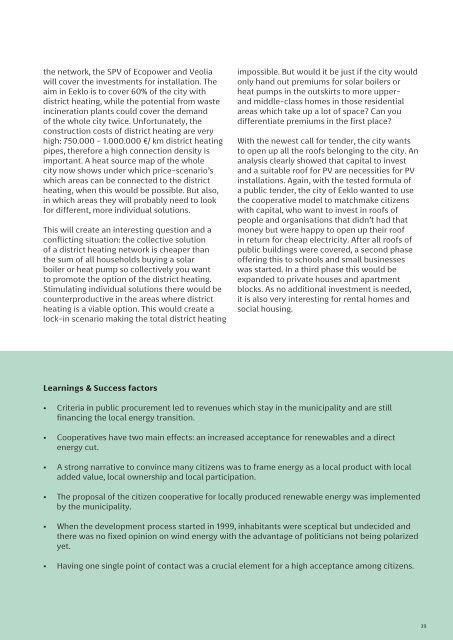Cities4PEDs Atlas_November 2021.pdf
Atlas - From 7 case interviews to recurring strategies and PED relevant aspects
Atlas - From 7 case interviews to recurring strategies and PED relevant aspects
- No tags were found...
Create successful ePaper yourself
Turn your PDF publications into a flip-book with our unique Google optimized e-Paper software.
the network, the SPV of Ecopower and Veolia<br />
will cover the investments for installation. The<br />
aim in Eeklo is to cover 60% of the city with<br />
district heating, while the potential from waste<br />
incineration plants could cover the demand<br />
of the whole city twice. Unfortunately, the<br />
construction costs of district heating are very<br />
high: 750.000 - 1.000.000 €/ km district heating<br />
pipes, therefore a high connection density is<br />
important. A heat source map of the whole<br />
city now shows under which price-scenario’s<br />
which areas can be connected to the district<br />
heating, when this would be possible. But also,<br />
in which areas they will probably need to look<br />
for different, more individual solutions.<br />
This will create an interesting question and a<br />
conflicting situation: the collective solution<br />
of a district heating network is cheaper than<br />
the sum of all households buying a solar<br />
boiler or heat pump so collectively you want<br />
to promote the option of the district heating.<br />
Stimulating individual solutions there would be<br />
counterproductive in the areas where district<br />
heating is a viable option. This would create a<br />
lock-in scenario making the total district heating<br />
impossible. But would it be just if the city would<br />
only hand out premiums for solar boilers or<br />
heat pumps in the outskirts to more upperand<br />
middle-class homes in those residential<br />
areas which take up a lot of space? Can you<br />
differentiate premiums in the first place?<br />
With the newest call for tender, the city wants<br />
to open up all the roofs belonging to the city. An<br />
analysis clearly showed that capital to invest<br />
and a suitable roof for PV are necessities for PV<br />
installations. Again, with the tested formula of<br />
a public tender, the city of Eeklo wanted to use<br />
the cooperative model to matchmake citizens<br />
with capital, who want to invest in roofs of<br />
people and organisations that didn’t had that<br />
money but were happy to open up their roof<br />
in return for cheap electricity. After all roofs of<br />
public buildings were covered, a second phase<br />
offering this to schools and small businesses<br />
was started. In a third phase this would be<br />
expanded to private houses and apartment<br />
blocks. As no additional investment is needed,<br />
it is also very interesting for rental homes and<br />
social housing.<br />
Learnings & Success factors<br />
• Criteria in public procurement led to revenues which stay in the municipality and are still<br />
financing the local energy transition.<br />
• Cooperatives have two main effects: an increased acceptance for renewables and a direct<br />
energy cut.<br />
• A strong narrative to convince many citizens was to frame energy as a local product with local<br />
added value, local ownership and local participation.<br />
• The proposal of the citizen cooperative for locally produced renewable energy was implemented<br />
by the municipality.<br />
• When the development process started in 1999, inhabitants were sceptical but undecided and<br />
there was no fixed opinion on wind energy with the advantage of politicians not being polarized<br />
yet.<br />
• Having one single point of contact was a crucial element for a high acceptance among citizens.<br />
Working document<br />
39


















